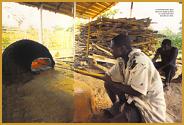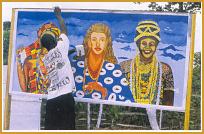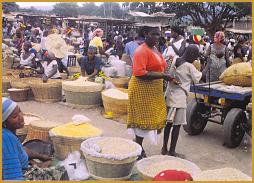|
Think of African beads and two images come to
mind: the first, glass trading beads brought from Venice and used in
the slave trade, and second, the tiny beads from the Czech Republic,
used by myriad African tribal peoples, including the Maasai, Samburu,
Zulu, and Yoruba. But there are also glass beads made in Africa, and
used by Africans, and these have a rich heritage, too. They are
found in one small area of Ghana, commonly known as the Gold Coast
among those who learned history before 1957. Located along the
coastline of Africa's northwestern "hump," Ghana is a
country of great heat, humidity, and cultural history.
On a continent often thought to be
unsophisticated in its material culture, Ghana artisans have
demonstrated a dazzling use of pattern and material in an abundant
range of crafts, from textiles to gold. It is here where the Asante
(also spelled Ashanti) flourished; it is the land of Kente cloth and
the famous Asante gold weights. The Asante culture was built around
a rich tradition often expressed in proverbs - proverbs that have
been condensed into single symbols that have meaning for the Asante.
Many of the universally understood symbols came to be fashioned
into gold weights. Gold weights (actually usually made of brass),
were needed in a culture in which gold dust was the medium of
exchange, the daily currency. Each merchant carried his personal set
of gold weights, usually 12 in all. There came to be thousands of
motifs in use, including porcupines, which represent the strength of
the warriors, the groundnut, a basic food, and the popular wari
board game, also known as mancala.
The kingdom was built on gold; the precious
metal was abundant and, as is often the case in African material
culture, the material at hand became the material of use. Gold
ornamentation, however, was restricted for royal use, although
perhaps restricted is not quite the right word. Within the
quite extensive royal community, gold was used lavishly to create
ornaments of astonishing variety and detail. It was used to such an
extent that when the Asantehene, the king of the Asante, was
on ceremonial display, he had to be carried - the weight of his gold
ornaments, the bracelets on his arms and legs, made it impossible
for him to move on his own. His staff was gold, the cloth he wore
included woven gold threads, his headpiece was of gold, his
daughters' faces were dusted and decorated with gold. The brilliant
yellow color of gold, the color that seems to capture the sun itself,
was reflected everywhere in the already brilliant sunshine of the
Gold Coast.
CEREMONIAL ROLE. But
the Asante gold-based culture is limited to the one area. In
the southeastern part of Ghana, a more humble object has become the
heart of the material culture. One of the oldest cultures, the
Dipo-Krobo people, part of the Ga-Adangbe linguistic group, claims a
small territory, no more than 70 miles from east to west and from
north to south. The heart of this cultural region is the village of
Odumase-Krobo, a drive of about 1 1/2 hours from Accra, on one of
Ghana's best roads. People such as the Krobo, who live close to the
coast, have come into contact with foreigners, both those from other
African cultures as well as Europeans. This has influenced their
language and some of their economic activities, but their
traditional cultural practices have managed to survive.
 Each
year, the Dipo-Krobo festival takes place, a very old tradition
among the Krobo people. The ritual marks the coming of age of Dipo
girls, and strands of glass beads play a large role. The villagers
prepare for the ritual for an entire year; during the ceremony,
which takes place over several days, the girls wear different
strands of colored beads and are redressed several times, exchanging
one color for another. Although each girl is draped in many strands
of beads, these likely are not her personal property. A woman
acquires beads throughout her life, and wears them proudly - some
she will receive from her mother, some she will buy for herself as
she can afford them, and some will be given to her by her
husband when she marries. During the ceremony, the girls stay
together, secluded from the other members of the group. In the past,
the ritual was a crucial step leading to marriage; the girls
would be instructed in the ways of their people, learning about the
moral and ethical rules and how to fit into their culture. Each
year, the Dipo-Krobo festival takes place, a very old tradition
among the Krobo people. The ritual marks the coming of age of Dipo
girls, and strands of glass beads play a large role. The villagers
prepare for the ritual for an entire year; during the ceremony,
which takes place over several days, the girls wear different
strands of colored beads and are redressed several times, exchanging
one color for another. Although each girl is draped in many strands
of beads, these likely are not her personal property. A woman
acquires beads throughout her life, and wears them proudly - some
she will receive from her mother, some she will buy for herself as
she can afford them, and some will be given to her by her
husband when she marries. During the ceremony, the girls stay
together, secluded from the other members of the group. In the past,
the ritual was a crucial step leading to marriage; the girls
would be instructed in the ways of their people, learning about the
moral and ethical rules and how to fit into their culture.
At the culmination of this ceremony, a girl
would be considered eligible for marriage and indeed, in the past,
would be married immediately and leave with her husband for her new
life. Traditionally, a husband could take his intended away when she
was just 14 or 15 years old, but times have changed. These days, a
potential husband must carve out his own farm before he can marry
and he must pay a dowry to the bride's family. Equally important,
girls once considered to be of marriageable age are now more likely
to be attending school. The ceremony interrupts their schooling for
several days, but when the ceremony is concluded, the girl will
likely return to school and continue her education rather than
taking up her duties as a very young wife.
The festival usually takes place in April, but
the date is not fixed and changes from year to year. The chief
determines when the ceremony will start, and it can be delayed for
several reasons - the moon may not be in the right position, for
example, or the chief may not have gotten enough money together to
pay for all the food needed to take care of the many people who come
to take part in the ceremony.
Originally, participation in the ritual was
strictly limited to pubescent girls. Today, however, if a
participating teenage girl has a younger sister, the little one will
take part as well, even though she is not considered ready for
marriage by any standard - a practical response to the enormous
expense involved in staging the ceremony. Because of the costs,
there is always the chance that the ceremony might not take place
when the younger sister comes of age and so she takes her place in
the event even when it is not really appropriate. Although the
ceremony is restricted to women, men may observe it; in many
cultures, coming of age ceremonies are limited to the one sex.
THE LOST-STRAW METHOD. The
beads are made by hand in Odumase- Krobo village using an age-old
glass making method, although today, the basic material comes from
recycled glass, mainly from imported bottles. The chief beadmaker is
a man named Nomada Djaba, known locally as Cedi (pronounced CD).
Whether by design or by coincidence, "Cedi" is also the
name of the currency in Ghana.
 Before
the bead making begins, Cedi and his helper form small, round, clay
molds that are baked in a kiln. Then the glass bottles are ground
into a fine powder which is poured, layer by layer, into five
rounded depressions in the molds. Before
the bead making begins, Cedi and his helper form small, round, clay
molds that are baked in a kiln. Then the glass bottles are ground
into a fine powder which is poured, layer by layer, into five
rounded depressions in the molds.
For varied-color glass, two or more layers of
different colors are used, then a sharp tool similar to an ice pick
is used to draw the color through the mixture. When the section is
filled, a straw is placed in the center of each mound of powdered
glass; during the firing, the straw burns out, leaving behind a hole
for stringing the beads. (One may call this the 'lost straw' method,
similar to the lost-wax method of casting gold.) After the beads are
fired and allowed to cool, they are washed in order to remove the
residue from the kiln. Finally, the beads are strung onto sisal or
other fibers to form long ropes.
The appearance of the beads varies from opaque
to translucent. Colors range from pale pastels to vibrant primary
colors. In addition to matte-finish, translucent beads of one solid
color, the bead maker offers variegated colored beads that may
include blue and green in the same bead. Some beads are completely
opaque with a shiny glazelike finish, while others include central
stripes decorated with bits of glittery sand. These are well
finished and are smooth to the touch. Not one of the beads is truly
round; they are more like cushions with slightly flat ends where
they are strung together. Strands are generally comprised of just
one color or type of bead, that is, the decorated beads are not
mixed with the monochromatic beads. According to Lois Dubin's History
of Beads, making beads using powdered glass is a technique
nearly unique to Africa. The practice has reached a remarkable level
of sophistication since it began, estimated to be some time in the
16th century.
Glass bead making in sub-Saharan Africa is
confined to a small area of West Africa in the countries known today
as Niger, Nigeria, and Ghana. But bead making is not an industry or
even a widely practiced craft, instead usually confined to a group
of families. Glass making in Ghana, specifically in the region where
the Dipo-Krobo people live, is a 'dedicated' craft, aimed at, and
guided by, the needs and demands of the local people; the people
need the beads for their ceremonies as much as they enjoy wearing
them. The makers and the initial consumers are all found in the same
town, and the beads are created almost to order by a small number of
craftsmen in one-man workshops.
 Cedi, however, also sells beads to visitors
who make their way to his own little shop. Outsiders are obvious, as
they usually come accompanied by a guide who knows the bead maker
and knows the way. On one of our more recent visits, the Italian
ambassador to Ghana and his family were also there, making their
choices. Some of Cedi's beads are sold in the local market, and he
also travels to Europe and the United States to sell his work. Cedi, however, also sells beads to visitors
who make their way to his own little shop. Outsiders are obvious, as
they usually come accompanied by a guide who knows the bead maker
and knows the way. On one of our more recent visits, the Italian
ambassador to Ghana and his family were also there, making their
choices. Some of Cedi's beads are sold in the local market, and he
also travels to Europe and the United States to sell his work.
Because the beads are made individually, the
colors can be varied at will, unlike the tiny, mass-produced glass
beads from the Czech Republic that are favored so widely in other
African cultures. Where the availability of the Czech-made beads
depends on the middlemen, usually Asian entrepreneurs, who bring
them to the markets in the many areas of Africa where they are used,
the color of the Ghanaian beads is dictated by the scarcity or
availability of the recycled glass. Certain colors are difficult to
obtain or not available at all.
 In rural Africa, open-air markets take
the place of supermarkets. In Odumasi-Krobo, a sprawling market
takes place twice a week. Early in the morning on market days,
vendors arrive and spread out their merchandise. The goods - whether
they are food, fabric, or furniture - become the display. A walk
through the local market takes the shopper past stalls offering
chickens and goats, vegetables and sandals, hair cuts and cooking
pots, anything and everything people in this area need. The bead
shopper must know exactly where to go. The bead sellers are tucked
into one small area of the market, reached only after a circuitous
path through the maze-like aisles. Although there are no set
prices in most places, and no price tags or signs, local people who
buy the same goods each week know the prices, and a little friendly
discussion is all that's needed to agree on a price. In rural Africa, open-air markets take
the place of supermarkets. In Odumasi-Krobo, a sprawling market
takes place twice a week. Early in the morning on market days,
vendors arrive and spread out their merchandise. The goods - whether
they are food, fabric, or furniture - become the display. A walk
through the local market takes the shopper past stalls offering
chickens and goats, vegetables and sandals, hair cuts and cooking
pots, anything and everything people in this area need. The bead
shopper must know exactly where to go. The bead sellers are tucked
into one small area of the market, reached only after a circuitous
path through the maze-like aisles. Although there are no set
prices in most places, and no price tags or signs, local people who
buy the same goods each week know the prices, and a little friendly
discussion is all that's needed to agree on a price.
Ghana offers a look at the "real"
Africa, where traditions are alive and where cultural expression is
part of daily life, not something performed for curious visitors.
These strands of glass beads are part of that expression, a
continuation of an ancient tradition. They also speak to the
universal love of adornment.
For more photos by Jason
Lauré visit his website at http://www.agpix.com/africatrek |